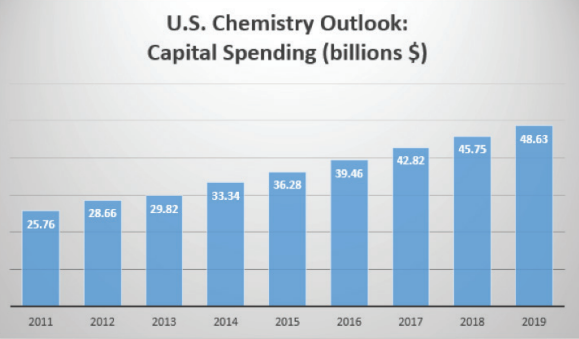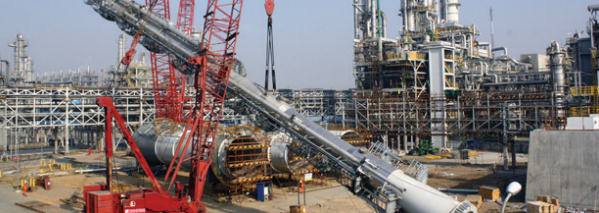Aligning expectations between project owners and EPC contractors
Driven by low feedstock costs, the petrochemical renaissance is reshaping North America’s industrial landscape. However, the ongoing high levels of industrial activity are increasing the complexity of new projects, sometimes fuelling a sense of disconnect between owners and contractors.

Managing risk in times of complexity and change requires bold and innovative solutions.
New strategies are vital to guarantee the constant alignment between project owners and Engineering, Procurement and Construction (EPC) contractors so that they can fully reap the benefits of the ongoing U.S. petrochemical renaissance.

Source: “Year-End 2014 Chemical Industry Situation and Outlook,” American Chemistry Council, December 2014
In particular, setting clear and shared project objectives from the beginning is paramount to prevent common problems such as time delays and cost escalation.
Increasing complexity
While new opportunities are blossoming for both petrochemical companies and for EPC contractors, there is widespread concern within the industry that the rising complexity of the projects can easily spiral out of control.
“The one thing that we have to realize is that the way we execute a project today is very different from the way a project would have been executed four years ago,” said Steve Cabano, owner of project management consulting and training firm Pathfinder LLC.
Increasing complexity can generate uncertainty. For example, while owners are still working on scoping the projects, contractors may already be working on the design and may have started buying some of the materials.
“The problem lies in the fact that owners, particularly in today’s environment, tend to be much more directly engaged. This is because schedules are so condensed,” said Lowell Wiles, group vice president at Jacobs Engineering.
Allocating risk
A big challenge is also that contracts often put a disproportionate amount of risk on one or the other party.
On the one hand, the owners of the petrochemical facilities feel that the burden of risk is excessively on their shoulders since they tend to be responsible for unforeseen events, according to force majeure contract clauses.
In most situations the owner is still eventually responsible. This means that if the facility is not ready on time and therefore does not produce according to schedule, the return on investment is going to be impacted.
In contrast, contractors say that they are taking more risk than owners typically acknowledge. Unforeseen events, such as sudden price increases of the materials, can easily put EPC companies in financial difficulties and even push them to the brink of bankruptcy.
EPC companies say that the growing scale of projects is transferring risks to the operators.
Thus, even if they devise several strategies to share risks with their partners, suppliers and subcontractors, EPC companies can still suffer from liquidating damages.
Aligning expectations
Aligning the expectations of owners and contractors at the beginning of a project lifecycle is a key prerequisite to avoid cost overruns and time delays.
“The project scope needs to be truly, fully and clearly defined during the business development cycle and the pre-award clarification meeting and, ideally, it is clearly written in the contract between the companies,” said Paul Dainora, director for Business Development - Petrochemical Plants at The Linde Group.
Once initial expectations have been thoroughly discussed and agreed upon, it is necessary to create effective strategies on how to handle change, for example by working jointly on risk management.
The need for open communication throughout the process is crucial, according to Peter Subtelny, senior consulting mechanical engineer at INEOS. Contractors could let the customer know about problems, especially those concerning costs and schedules.
Reports could be issued on a regular basis from the start to avoid problems. Their frequency and level of detail should be agreed from the beginning, experts say.
Only a smooth flow of information, implemented through regular face-to-face meetings and conference calls, can guarantee the constant alignment of expectations, which is key to success.
Indeed, effective and timely communication throughout the process is an essential prerequisite to ensure that the roles and expectations of owners and contractors remain balanced and well tailored to their respective strengths.
“All projects that I have known who have gone well have been resolved through a very good alignment between the owner and the contractor. So alignment is critical, and keeping that alignment is very critical,” Wiles said.

 Credit: AnetteAndersen
Credit: AnetteAndersen
Alignment sessions
Formal alignment sessions and joint scrutiny can be useful tools for risk management. The former is a formal process in which parties spend several days discussing the project and drawing hard boundaries around that scope.
These sessions help the two teams overcome their differences. This strategy can also be applied to successfully integrate international contractors that lack a presence in the North American market.
The importance of informal team building activities to develop a relationship at an early stage should not be underestimated, according to experts. Both formal and informal alignment play a major role in developing trust and effective communication. These qualities are valuable in difficult situations, especially when dealing with project changes.
Regular project reviews could also be scheduled between senior executives of the owner and the contractor companies to assess the project performance. Joint scrutiny brings transparency to the project and contributes to foster collaboration and team spirit.
These strategies will help the industry cope with complexity and change, preventing delays and cost increases, while making the most of the current climate.
